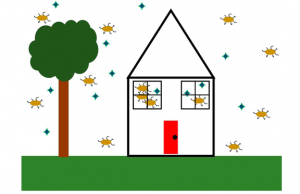Maria Gloria Dominguez-Bello gives a wonderful talk about the “Microbial Biogeography of Homes across urbanization gradients.” This was recorded at the MoBE 2017 symposium in Washington D.C. If you’re interested, check out all of the other speakers from MoBE 2017 on our YouTube channel!
Legionella is a bacterium found in drinking water distributions systems, as well as premise plumbing, hot tubs, hot water heaters, cooling towers, and other building water systems. At high enough concentrations and when inhaled, Legionella can cause Legionnaires’ disease and Pontiac fever, the former of which can be fatal if infected people are not treated …
This may be of interest: Fungal Communities Including Plant Pathogens in Near Surface Air Are Similar across Northwestern Europe Nicolaisen M, West JS, Sapkota R, Canning GGM, Schoen C and Justesen AF (2017) Fungal Communities Including Plant Pathogens in Near Surface Air Are Similar across Northwestern Europe. Front. Microbiol. 8:1729. doi: 10.3389/fmicb.2017.01729 Information on the …
At the recent NAS MOBE meeting there was some discussion of some potential ethical concerns associated with one of the projects discussed (work of Eric Alm where he was collecting samples from urban water systems and trying to infer information about communities and residents). OK #MOBE17 and others out there – I am getting …
An update on this story Managing Legionella in Water Systems Nominate Experts for an Upcoming Consensus Project The National Academies of Sciences, Engineering, and Medicine will undertake a project on the management of Legionella in water systems. An ad hoc committee will review the state of science with respect to Legionella contamination of water systems and issue a report that will: describe the microbial …
Hi MoBE blog, I just wanted to share a piece that I recently wrote for a Special Issue on the journal Microbial Biotechnology. The Special issue presents a collection articles about “The contribution of microbial biotechnology to sustainable development goals”, and the title of my article is “Microbial communities as biosensors for monitoring urban …
Quick post here — prepping for #MoBE17 meeting and found this new paper. It seems like it is worth a look: City-scale distribution and dispersal routes of mycobiome in residences: Microbiome. 2017 Oct 4;5(1):131. doi: 10.1186/s40168-017-0346-7. Abstract BACKGROUND: Pathogenic and allergenic bacteria and fungi within the indoors can bring detrimental health effects on the occupants. We …
A new episode of “Food for Thought” from NPR on kitchen sponge microbes. By Michaeleen Doucleff:
This seems worth looking over: The Looming Consequences of Mold in Houston by James Hamblin in The Atlantic. The article has a discussion of mold and moisture and the microbiology of the built environment. It includes a discussion of some of the experiences and work of Joan Bennett who is a well known expert in …
In the world of built environment (BE) microbiome research, we are by now well aware that building designs have influences on the indoor microbial assemblage. Therefore, BEs that employ a multitude of innovative designs, such as green and zero carbon buildings (GBs and ZCBs), may provide us greater insight on the mechanistic basis for …








